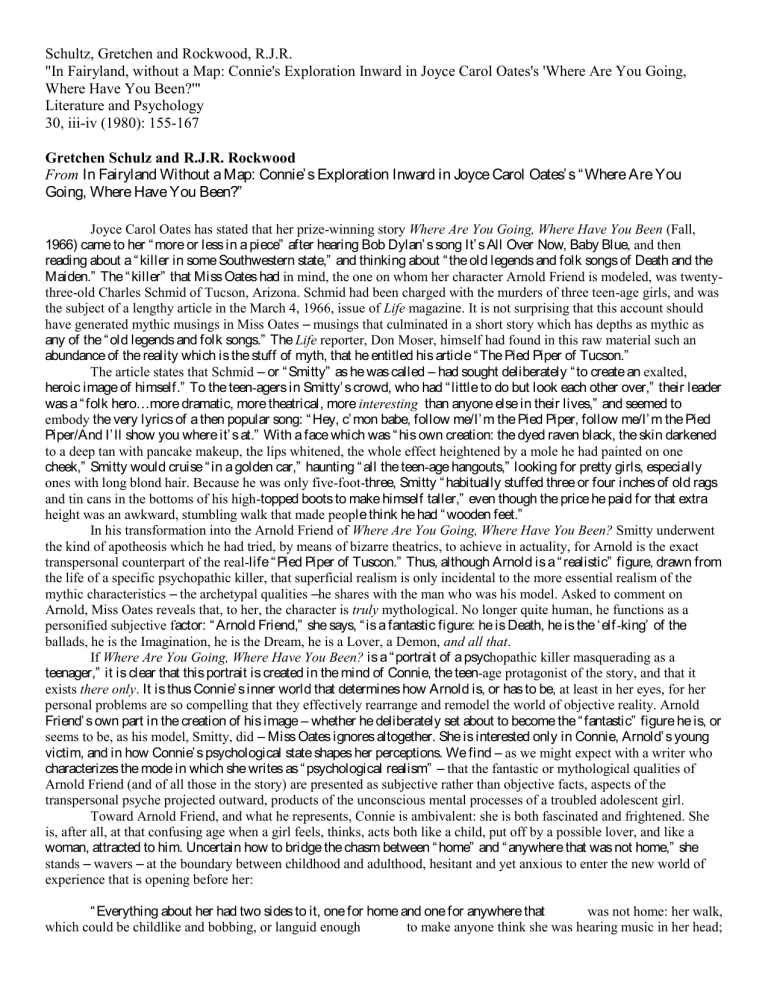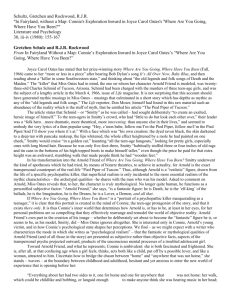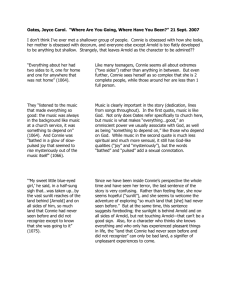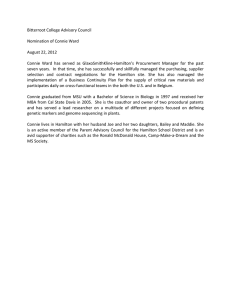
Schultz, Gretchen and Rockwood, R.J.R. "In Fairyland, without a Map: Connie's Exploration Inward in Joyce Carol Oates's 'Where Are You Going, Where Have You Been?'" Literature and Psychology 30, iii-iv (1980): 155-167 Gretchen Schulz and R.J.R. Rockwood From In Fairyland Without a Map: Connie’ s Exploration Inward in Joyce Carol Oates’ s “ Where Are You Going, Where Have You Been?” Joyce Carol Oates has stated that her prize-winning story Where Are You Going, Where Have You Been (Fall, 1966) came to her “ more or less in a piece” after hearing Bob Dylan’ s song It’ s All Over Now, Baby Blue, and then reading about a “ killer in some Southwestern state,” and thinking about “ the old legends and folk songs of Death and the Maiden.” The “ killer” that Miss Oates had in mind, the one on whom her character Arnold Friend is modeled, was twentythree-old Charles Schmid of Tucson, Arizona. Schmid had been charged with the murders of three teen-age girls, and was the subject of a lengthy article in the March 4, 1966, issue of Life magazine. It is not surprising that this account should have generated mythic musings in Miss Oates – musings that culminated in a short story which has depths as mythic as any of the “ old legends and folk songs.” The Life reporter, Don Moser, himself had found in this raw material such an abundance of the reality which is the stuff of myth, that he entitled his article “ The Pied Piper of Tucson.” The article states that Schmid – or “ Smitty” as he was called – had sought deliberately “ to create an exalted, heroic image of himself.” To the teen-agers in Smitty’ s crowd, who had “ little to do but look each other over,” their leader was a “ folk hero…more dramatic, more theatrical, more interesting than anyone else in their lives,” and seemed to embody the very lyrics of a then popular song: “ Hey, c’ mon babe, follow me/I’ m the Pied Piper, follow me/I’ m the Pied Piper/And I’ ll show you where it’ s at.” With a face which was “ his own creation: the dyed raven black, the skin darkened to a deep tan with pancake makeup, the lips whitened, the whole effect heightened by a mole he had painted on one cheek,” Smitty would cruise “ in a golden car,” haunting “ all the teen-age hangouts,” looking for pretty girls, especially ones with long blond hair. Because he was only five-foot-three, Smitty “ habitually stuffed three or four inches of old rags and tin cans in the bottoms of his high-topped boots to make himself taller,” even though the price he paid for that extra height was an awkward, stumbling walk that made people think he had “ wooden feet.” In his transformation into the Arnold Friend of Where Are You Going, Where Have You Been? Smitty underwent the kind of apotheosis which he had tried, by means of bizarre theatrics, to achieve in actuality, for Arnold is the exact transpersonal counterpart of the real-life “ Pied Piper of Tuscon.” Thus, although Arnold is a “ realistic” figure, drawn from the life of a specific psychopathic killer, that superficial realism is only incidental to the more essential realism of the mythic characteristics – the archetypal qualities –he shares with the man who was his model. Asked to comment on Arnold, Miss Oates reveals that, to her, the character is truly mythological. No longer quite human, he functions as a personified subjective factor: “ Arnold Friend,” she says, “ is a fantastic figure: he is Death, he is the ‘ elf-king’ of the ballads, he is the Imagination, he is the Dream, he is a Lover, a Demon, and all that. If Where Are You Going, Where Have You Been? is a “ portrait of a psychopathic killer masquerading as a teenager,” it is clear that this portrait is created in the mind of Connie, the teen-age protagonist of the story, and that it exists there only. It is thus Connie’ s inner world that determines how Arnold is, or has to be, at least in her eyes, for her personal problems are so compelling that they effectively rearrange and remodel the world of objective reality. Arnold Friend’ s own part in the creation of his image – whether he deliberately set about to become the “ fantastic” figure he is, or seems to be, as his model, Smitty, did – Miss Oates ignores altogether. She is interested only in Connie, Arnold’ s young victim, and in how Connie’ s psychological state shapes her perceptions. We find – as we might expect with a writer who characterizes the mode in which she writes as “ psychological realism” – that the fantastic or mythological qualities of Arnold Friend (and of all those in the story) are presented as subjective rather than objective facts, aspects of the transpersonal psyche projected outward, products of the unconscious mental processes of a troubled adolescent girl. Toward Arnold Friend, and what he represents, Connie is ambivalent: she is both fascinated and frightened. She is, after all, at that confusing age when a girl feels, thinks, acts both like a child, put off by a possible lover, and like a woman, attracted to him. Uncertain how to bridge the chasm between “ home” and “ anywhere that was not home,” she stands – wavers – at the boundary between childhood and adulthood, hesitant and yet anxious to enter the new world of experience that is opening before her: “ Everything about her had two sides to it, one for home and one for anywhere that was not home: her walk, which could be childlike and bobbing, or languid enough to make anyone think she was hearing music in her head; her mouth, which was pale and smirking most of the time, but bright and pink on these evenings out; her laugh, which was cynical and drawling at home – ‘ ha ha, very funny,’ but high-pitched and nervous anywhere else, like the jingling of the charms on her bracelet.” That her laugh is “ high-pitched and nervous” when she is “ anywhere that was not home” betrays the fact that Connie, like all young people, needs help as she begins to move from the past to the future, as she begins the perilous inward journey towards maturity. This journey is an essential part of the adolescent’ s search for personal identity, and though it is a quest that he or she must undertake alone, traditionally it has been the responsibility of culture to help by providing symbolic maps of the territory through which the teenager will travel, territory that lies on the other side of consciousness. Such models of behavior and maps of the unknown are generally provided by the products of fantasy – myth, legend, and folklore. Folk fairy tales have been especially useful in this way. In his book, The Uses of Enchantment: The Meaning and Importance of Fairy Tales (1976), Bruno Bettelheim argues that children’ s fairy tales offer “ symbolic images” that suggest “ happy solutions” to the problems of adolescence. In her fiction both short and long Miss Oates makes frequent use of fairy tale material. Again and again she presents characters and situations which parallel corresponding motifs from the world of folk fantasy. And never is this more true than in the present story. Woven into the complex texture of Where Are You Going, Where Have You Been? are motifs from such tales as Snow White, Cinderella, Sleeping Beauty, Little Red Riding Hood, and The Three Little Pigs. The Pied Piper of Hamelin, which ends tragically and so according to Bettelheim does not qualify as a proper fairy tale, serves as the “ frame device” that contains all of the other tales. There is a terrible irony here, for although the story is full of fairy tales, Connie, its protagonist, is not. Connie represents an entire generation of young people who have grown up – or tried to – without the help of those bedtime stories which not only entertain the child, but also enable him or her vicariously to experience and work through problems which he will encounter in adolescence. The only “ stories” Connie knows are those of the sexually provocative but superficial lyrics of the popular songs she loves or the equally insubstantial movies she attends. Such songs and movies provide either no models of behavior for her to imitate, or dangerously inappropriate ones. Connie has thus been led to believe that life, and in particular, love will be “ sweet, gentle, the way it was in the movies and promised in songs.” She has no idea that life actually can be just as grim as in folk fairy tales. The society that is depicted in Where Are You Going, Where Have You Been? has failed to make available to children like Connie maps of the unconscious such as fairy tales provide, because it has failed to recognize that in the unconscious, past and future coalesce, and that, psychologically, where the child is going is where he or she has already been. Since Connie has been left – in the words of yet another of the popular songs – to “ wander through that wonderland alone” – it is small wonder, considering her lack of spiritual preparation, that Connie’ s journey there soon becomes a terrifying schizophrenic separation from reality, with prognosis for recovery extremely poor… Had she been nurtured on fairy tales instead of popular songs and movies she would not feel at such a loss; she would have “ been” to this world before, through the vicarious experience offered by fairy tales, and she would have some sense of how to survive there now. Connie lacks the benefit of such experience, however, and even Arnold Friend appears to realize how that lack has hampered her development. He certainly speaks to the supposed woman as though she were still a child: “ ‘ Now, turn this way. That’ s right. Come over here to me…and let’ s see a smile, try it, you’ re a brave, sweet little girl’ .” How fatherly he sounds. And how like the Woodcutter. But we know he is still the Wolf, and that he still intends to “ gobble up” this “ little girl” as soon as he gets the chance. Connie is not going to live happily ever after. Indeed, it would seem that she is not going to live at all. She simply does not know how. She is stranded in Fairyland, without a map.





